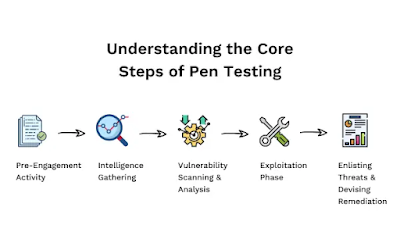It is therefore equally vital to invest in web application security testing of the measures opted as agencies, organizations and companies alike are becoming increasingly aware of the ever-present web application security threats. This article provides a comprehensive guide to web app security testing, with benefits and DIY steps.
Web Application Security Testing- What Is It?
Web application security testing is the process of evaluating the security of an organization's web applications. This is done manually or by making use of automated tools. The goal of web application security testing is to find and fix vulnerabilities in the web application before they are exploited by attackers.
Different types of web application security testing are:
- Penetration testing
This type of security testing is done to identify the vulnerabilities of an organization's web applications. The tester tries to exploit the vulnerabilities to see how much damage they can do.
Different types of penetration testing include:
- Black box testing: This type of penetration testing is done without any prior knowledge of the application. The tester tries to find vulnerabilities by probing the application as if they are an attacker.
- White box testing: This type of penetration testing is done with prior knowledge of the application. With beforehand access to the source code, the tester tries to find vulnerabilities as if they are an attacker.
- Gray box testing: In this type of penetration testing, the tester has some knowledge about how the application works but not much information is provided. The tester tries to probe and test for security flaws as if they were a malicious user with some knowledge of the internal workings of the app.
- Vulnerability scanning
This type of security testing is used to find and fix vulnerabilities in an organization's web applications. It scans the web application for known vulnerabilities and provides a report on the findings.
- Security assessment
A security assessment is a comprehensive evaluation of the security posture of an organization's web applications. It includes penetration testing, vulnerability scanning, and other tests depending on the organization's needs.
Web Application Security Testing- What Benefits Does It Offer?
There are many benefits to performing regular web application security tests, including:
- Fixing vulnerabilities after finding them before exploitation by attackers.
- Reducing the cost and effort needed to fix application vulnerabilities after a security incident.
- Finding new web app vulnerabilities that may have been missed during the development or testing stages.
- Helping secure an organization's reputation by preventing attackers from exploiting its applications and services, which can result in damage to the brand.
- The reduced risk of breaches in data and other cyber attack forms.
- The holistic security posture of the organization is made better.
- Faster time to market for web applications.
Web Application Security Testing- What Are The Tools For It?
Manual security testing of web apps can be difficult. Many tools are readily available that makes it easy to perform automated tests, including:
- Astra Pentest
Astra Pentest is an automated web application security testing tool, available freely and as a paid version, that can be used to test for vulnerabilities such as SQL injection, cross-site scripting (XSS), and broken authentication.
- Burp Suite
This integrated platform is apt for performing security testing of web applications as it is available as a free and paid version. It includes a tool for automated scanning of web applications, called Burp Scanner, as well as a variety of other tools for manual testing. It includes tools like a proxy, spider, intruder, repeater, decoder, and comparer.
- NeXpose Community Edition
NeXpose Community Edition is a free vulnerability scanner that can be used to scan for vulnerabilities in web applications. It has a database of over 200,000 known vulnerabilities.
- WebInspect
It is a commercial web application security assessment tool from HP. It includes features like spidering, crawling, and brute force password cracking.
- Netsparker
This is a free trial web application security scanner that scans for vulnerabilities in the target web app. Once it has found any, it generates reports on how to fix them.
- Acunetix WVS & NGS
These are automated tools used to find and exploit different types of vulnerabilities including OWASP's top ten security flaws like SQL injection, cross-site scripting, etc. They provide detailed vulnerability assessment reports which can be used by developers to quickly resolve issues before they affect their users' privacy or data integrity. The DAST can assist you in identifying vulnerabilities in your programme even before any input is provided. It is not intended to operate on specific software, but rather on the application layer, where genuine apps are susceptible.
What Are The DIY Steps To Web Application Security Testing?
Follow this number of steps you can take to DIY your own web app security test. These include:
- Identifying what areas you want to test (e.g., authentication, SQL injection, or cross-site scripting).
- Creating an actionable test plan (e.g., identifying what tests to run and in which order).
- Conducting web application security testing (e.g., using automated scanners or manual pen testing techniques).
- Results of the security testing reports are reported. (e.g., what vulnerabilities were found and how to fix them).
Conclusion
Web application security is a critical part of protecting your organization and safeguarding its data. By performing regular web application security tests, you can find and fix vulnerabilities before they are exploited by attackers. There are many tools available that make it easy to perform automated DIY web application security testing, including Astra's Pentest, Burp Suite, Netsparker, Acunetix WVS & NGS, and more!

